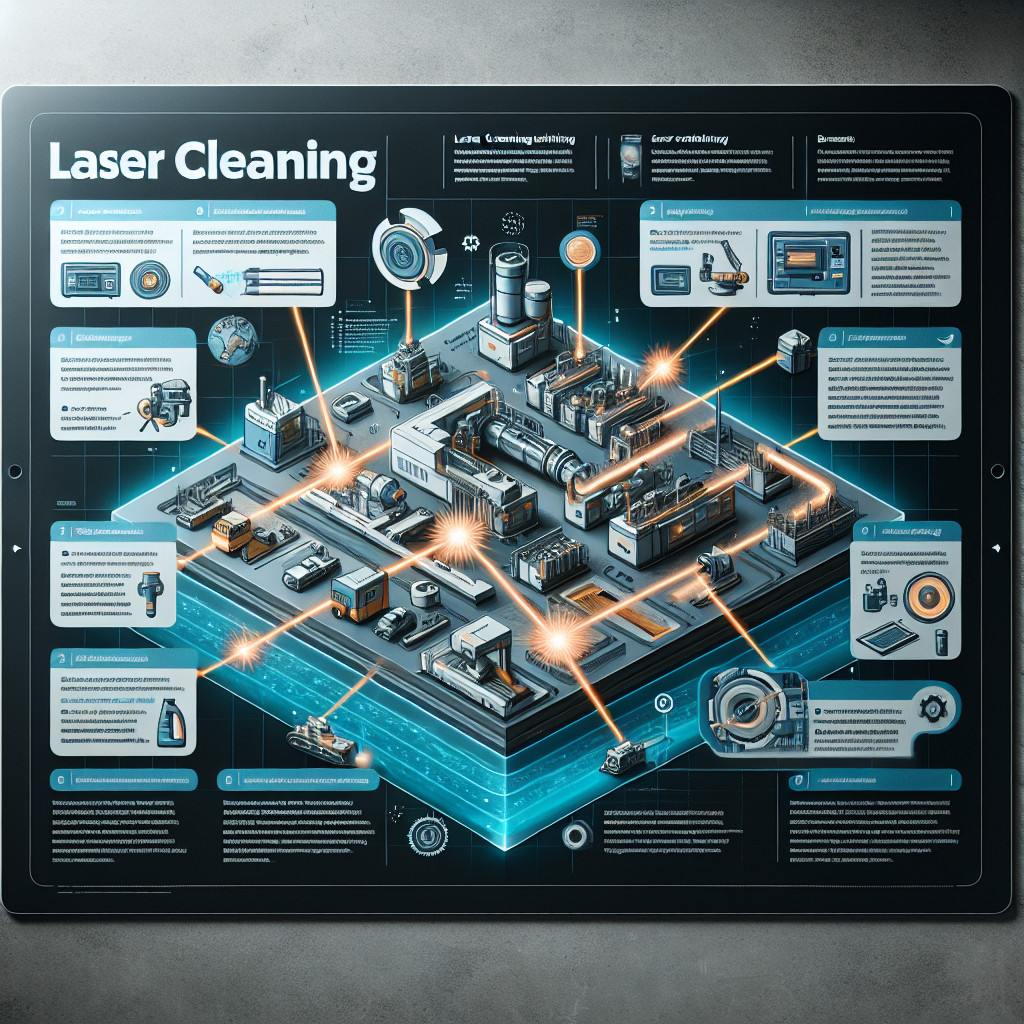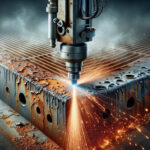Laser cleaning for removing oil and grease from machinery
- The benefits of laser cleaning for industrial machinery
- Comparison of laser cleaning vs traditional cleaning methods for removing oil and grease
- The effectiveness of laser cleaning in removing oil and grease from different types of machinery
- Case studies of successful applications of laser cleaning for oil and grease removal
- Safety considerations when using laser cleaning for machinery maintenance
The benefits of laser cleaning for industrial machinery
1. Precision cleaning
One of the key benefits of laser cleaning is its ability to provide precise and targeted cleaning. The laser beam can be focused on specific areas of the machinery, allowing for thorough cleaning without damaging the underlying surface. This level of precision is particularly important for delicate or intricate machinery components that require careful cleaning.
2. Environmentally friendly
Laser cleaning is an environmentally friendly cleaning method that does not produce any harmful by-products or waste. Unlike traditional cleaning methods that rely on chemicals or abrasive materials, laser cleaning uses only a high-powered laser beam to remove contaminants. This makes it a sustainable and eco-friendly option for industrial machinery cleaning.
3. Cost-effective
Although laser cleaning technology may have a higher upfront cost compared to traditional cleaning methods, it can ultimately save money in the long run. Laser cleaning is a highly efficient process that requires minimal maintenance and downtime, resulting in lower overall cleaning costs for industrial machinery. Additionally, the precision cleaning capabilities of laser technology can help prevent damage to machinery components, reducing the need for costly repairs or replacements.
4. Improved safety
Laser cleaning eliminates the need for harsh chemicals and abrasive materials, making it a safer cleaning option for industrial machinery operators. Traditional cleaning methods can pose health and safety risks to workers due to exposure to toxic chemicals or inhalation of abrasive particles. Laser cleaning eliminates these risks, creating a safer working environment for employees.
5. Versatility
Laser cleaning technology is highly versatile and can be used on a wide range of industrial machinery surfaces. Whether cleaning metal, plastic, or composite materials, laser cleaning can effectively remove contaminants and coatings without causing damage to the underlying surface. This versatility makes laser cleaning a valuable tool for a variety of industrial cleaning applications.
Conclusion
Overall, laser cleaning offers numerous benefits for industrial machinery cleaning, including precision cleaning, environmental sustainability, cost-effectiveness, improved safety, and versatility. As the manufacturing sector continues to adopt advanced technologies, laser cleaning is becoming an increasingly popular choice for maintaining and preserving industrial machinery. With its ability to provide efficient and effective cleaning without the use of harsh chemicals or abrasive materials, laser cleaning is revolutionizing the way industrial machinery is cleaned and maintained.
Comparison of laser cleaning vs traditional cleaning methods for removing oil and grease
Laser cleaning
Laser cleaning is a relatively new technology that uses a high-powered laser beam to remove contaminants from surfaces. The laser beam is directed at the surface, where it heats up and vaporizes the oil and grease, leaving behind a clean surface. Laser cleaning is a non-contact method, which means that it does not require any physical contact with the surface being cleaned.
- Advantages of laser cleaning:
- Efficiency: Laser cleaning is a very efficient method for removing oil and grease from surfaces. It can remove contaminants quickly and effectively, leaving behind a clean surface.
- Precision: Laser cleaning is a precise method that can be used to target specific areas on a surface. This makes it ideal for cleaning delicate or intricate surfaces.
- Environmentally friendly: Laser cleaning does not use any chemicals or solvents, making it an environmentally friendly cleaning method.
Traditional cleaning methods
Traditional cleaning methods, such as using solvents or detergents, are commonly used to remove oil and grease from surfaces. These methods involve applying a cleaning solution to the surface and then scrubbing or wiping away the contaminants. Traditional cleaning methods can be effective, but they can also be time-consuming and labor-intensive.
- Advantages of traditional cleaning methods:
- Accessibility: Traditional cleaning methods are widely available and easy to use. They do not require any specialized equipment or training.
- Cost-effective: Traditional cleaning methods are often more cost-effective than laser cleaning, especially for small-scale cleaning tasks.
- Versatility: Traditional cleaning methods can be used on a wide range of surfaces and materials.
Conclusion
In conclusion, both laser cleaning and traditional cleaning methods have their own advantages and disadvantages when it comes to removing oil and grease from surfaces. Laser cleaning is a highly efficient and precise method that is environmentally friendly, but it can be more expensive and require specialized equipment. Traditional cleaning methods are more accessible and cost-effective, but they can be time-consuming and labor-intensive. Ultimately, the choice between the two methods will depend on the specific cleaning requirements and budget constraints of the user.
The effectiveness of laser cleaning in removing oil and grease from different types of machinery
How does laser cleaning work?
Laser cleaning is a non-contact, non-abrasive method that uses a high-intensity laser beam to remove contaminants from surfaces. When the laser beam hits the surface, it vaporizes the oil and grease, leaving behind a clean surface. The process is highly precise and can be adjusted to remove different types of contaminants without damaging the underlying material.
The benefits of laser cleaning
- Efficiency: Laser cleaning is a fast and efficient method for removing oil and grease from machinery. It can be done in a fraction of the time compared to traditional cleaning methods.
- Environmentally friendly: Laser cleaning does not require the use of chemical solvents, making it a more environmentally friendly option. It also produces minimal waste and does not release harmful fumes into the air.
- Precision: Laser cleaning is a highly precise method that can be tailored to remove specific contaminants without damaging the underlying material. This makes it ideal for delicate machinery or intricate parts.
- Cost-effective: While the initial investment in laser cleaning equipment may be higher than traditional cleaning methods, the long-term cost savings can be significant. Laser cleaning requires less labor and fewer consumables, resulting in lower overall maintenance costs.
Applications of laser cleaning in different types of machinery
Laser cleaning can be used in a wide range of industries and applications to remove oil and grease from various types of machinery. Some common examples include:
- Automotive industry: Laser cleaning can be used to remove oil and grease from engine components, transmission parts, and other automotive machinery.
- Aerospace industry: Laser cleaning is ideal for removing contaminants from aircraft engines, landing gear, and other aerospace components.
- Manufacturing industry: Laser cleaning can be used to clean molds, dies, and other machinery used in the manufacturing process.
- Power generation industry: Laser cleaning can be used to remove oil and grease from turbines, generators, and other power generation equipment.
Conclusion
Laser cleaning is a highly effective method for removing oil and grease from different types of machinery. Its efficiency, precision, and environmental friendliness make it a preferred choice for many industries. While the initial investment in laser cleaning equipment may be higher, the long-term cost savings and benefits make it a worthwhile investment for companies looking to improve their cleaning processes.
Case studies of successful applications of laser cleaning for oil and grease removal
Case Study 1: Automotive Industry
In the automotive industry, oil and grease buildup on engine parts can lead to decreased performance and efficiency. A leading car manufacturer implemented laser cleaning technology to remove oil and grease from engine components. The laser was able to precisely target and remove the contaminants without damaging the underlying surface. This resulted in improved engine performance and reduced maintenance costs.
| Surface | Contaminants | Results |
|---|---|---|
| Engine components | Oil and grease | Improved performance and reduced maintenance costs |
Case Study 2: Manufacturing Industry
In the manufacturing industry, oil and grease can accumulate on machinery and equipment, leading to operational inefficiencies. A manufacturing plant adopted laser cleaning technology to remove oil and grease from production equipment. The laser was able to effectively clean the surfaces, resulting in increased productivity and reduced downtime.
| Surface | Contaminants | Results |
|---|---|---|
| Production equipment | Oil and grease | Increased productivity and reduced downtime |
Case Study 3: Aerospace Industry
In the aerospace industry, oil and grease can pose a serious safety risk if not properly removed from aircraft components. A leading aerospace company utilized laser cleaning technology to remove oil and grease from critical aircraft parts. The laser was able to clean the surfaces with precision, ensuring the safety and reliability of the aircraft.
| Surface | Contaminants | Results |
|---|---|---|
| Aircraft components | Oil and grease | Ensured safety and reliability of aircraft |
Overall, these case studies demonstrate the effectiveness of laser cleaning technology for the removal of oil and grease from various surfaces. This innovative method offers numerous benefits, including improved performance, increased productivity, and enhanced safety. As industries continue to adopt laser cleaning technology, we can expect to see even more successful applications in the future.
Safety considerations when using laser cleaning for machinery maintenance
Laser cleaning is a highly effective method for removing rust, paint, and other contaminants from machinery surfaces. However, it is important to take safety precautions when using this technology to prevent accidents and injuries. Here are some key safety considerations to keep in mind when using laser cleaning for machinery maintenance:
1. Protective gear: When using laser cleaning equipment, it is essential to wear appropriate protective gear to prevent exposure to harmful laser radiation. This includes safety goggles that are specifically designed to block the wavelength of the laser being used.
2. Training: Before using laser cleaning equipment, operators should undergo thorough training on how to safely operate the machinery. This training should cover proper handling of the equipment, as well as safety protocols to follow during the cleaning process.
3. Area preparation: Before starting the laser cleaning process, the work area should be properly prepared to ensure the safety of everyone involved. This includes removing any flammable materials from the vicinity of the machinery being cleaned and ensuring that there are no obstructions that could interfere with the laser beam.
4. Fire prevention: Laser cleaning can generate heat, which can pose a fire hazard if not properly managed. It is important to have fire extinguishers readily available in case of an emergency, and to follow proper fire prevention protocols during the cleaning process.
5. Proper ventilation: Laser cleaning can produce fumes and vapors that may be harmful if inhaled. It is important to ensure that the work area is well-ventilated to prevent the buildup of these harmful substances. If necessary, operators should wear respiratory protection to prevent inhalation of fumes.
6. Equipment maintenance: Regular maintenance of laser cleaning equipment is essential to ensure its safe and effective operation. This includes checking for any signs of wear or damage, and replacing any worn components as needed.
7. Emergency procedures: In the event of an accident or injury during the laser cleaning process, operators should be familiar with emergency procedures to follow. This may include contacting emergency services, administering first aid, and evacuating the area if necessary.
By following these safety considerations, operators can minimize the risks associated with using laser cleaning for machinery maintenance and ensure a safe working environment for everyone involved. Remember, safety should always be the top priority when using any type of machinery maintenance equipment. Stay safe and happy cleaning! 🛠️👷♂️🔥
- Laser cleaning for removing oil and grease from machinery - 18 July 2024
- Kanban vs Scrum – which method to choose? - 13 April 2024
- Minimum Viable Product – why it matters? - 16 January 2024


